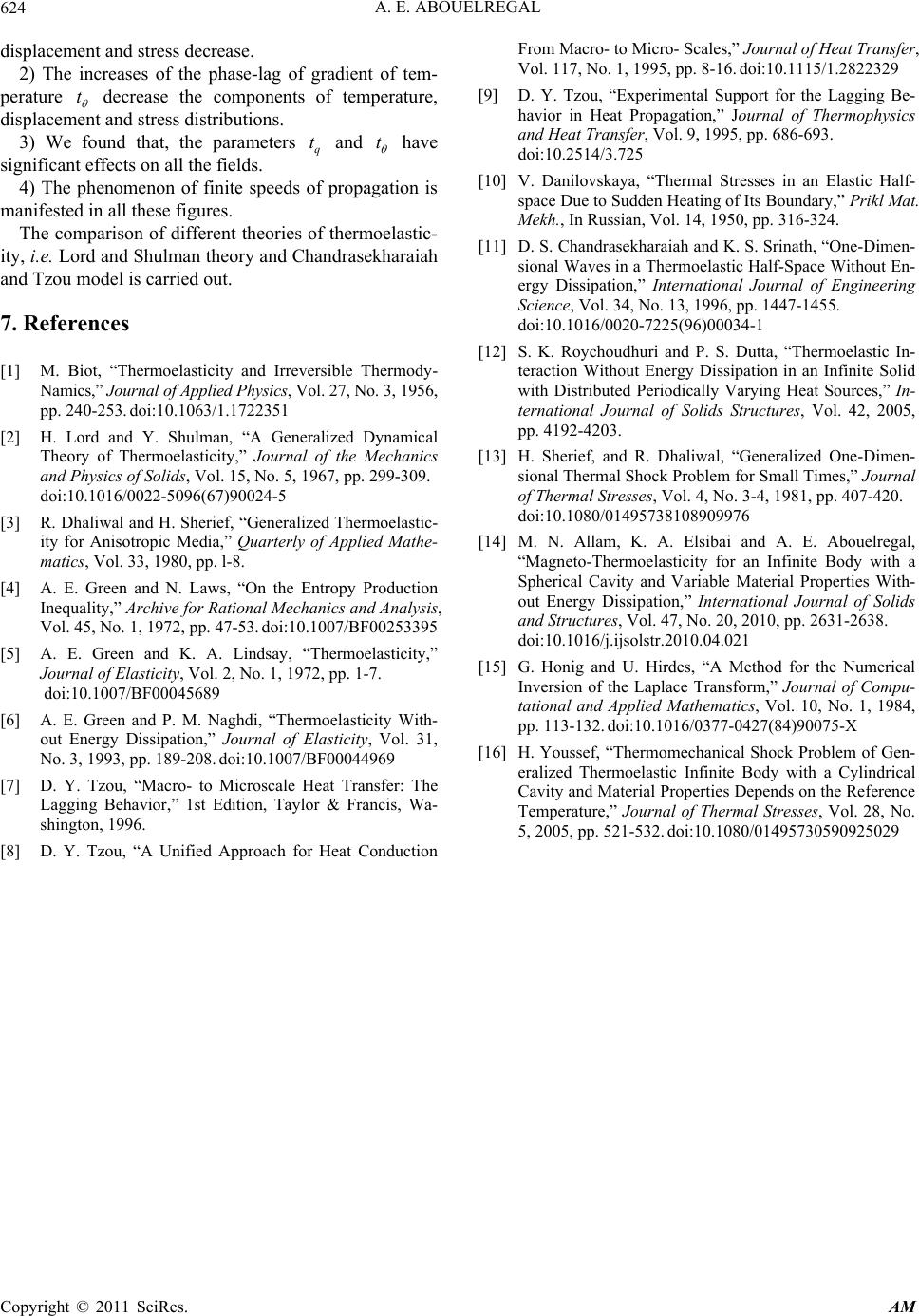
A. E. ABOUELREGAL
Copyright © 2011 SciRes. AM
624
displacement and stress decrease.
2) The increases of the phase-lag of gradient of tem-
perature t
decrease the components of temperature,
displacement and stress distributions.
3) We found that, the parameters and
q
tt
have
significant effects on all the fields.
4) The phenomenon of finite speeds of propagation is
manifested in all these figures.
The comparison of different theories of thermoelastic-
ity, i.e. Lord and Shulman theory and Chandrasekharaiah
and Tzou model is carried out.
7. References
[1] M. Biot, “Thermoelasticity and Irreversible Thermody-
Namics,” Journal of Applied Physics, Vol. 27, No. 3, 1956,
pp. 240-253. doi:10.1063/1.1722351
[2] H. Lord and Y. Shulman, “A Generalized Dynamical
Theory of Thermoelasticity,” Journal of the Mechanics
and Physics of Solids, Vol. 15, No. 5, 1967, pp. 299-309.
doi:10.1016/0022-5096(67)90024-5
[3] R. Dhaliwal and H. Sherief, “Generalized Thermoelastic-
ity for Anisotropic Media,” Quarterly of Applied Mathe-
matics, Vol. 33, 1980, pp. l-8.
[4] A. E. Green and N. Laws, “On the Entropy Production
Inequality,” Archive for Rational Mechanics and Analysis,
Vol. 45, No. 1, 1972, pp. 47-53. doi:10.1007/BF00253395
[5] A. E. Green and K. A. Lindsay, “Thermoelasticity,”
Journal of Elasticity, Vol. 2, No. 1, 1972, pp. 1-7.
doi:10.1007/BF00045689
[6] A. E. Green and P. M. Naghdi, “Thermoelasticity With-
out Energy Dissipation,” Journal of Elasticity, Vol. 31,
No. 3, 1993, pp. 189-208. doi:10.1007/BF00044969
[7] D. Y. Tzou, “Macro- to Microscale Heat Transfer: The
Lagging Behavior,” 1st Edition, Taylor & Francis, Wa-
shington, 1996.
[8] D. Y. Tzou, “A Unified Approach for Heat Conduction
From Macro- to Micro- Scales,” Journal of Heat Transfer,
Vol. 117, No. 1, 1995, pp. 8-16. doi:10.1115/1.2822329
[9] D. Y. Tzou, “Experimental Support for the Lagging Be-
havior in Heat Propagation,” Journal of Thermophysics
and Heat Transfer, Vol. 9, 1995, pp. 686-693.
doi:10.2514/3.725
[10] V. Danilovskaya, “Thermal Stresses in an Elastic Half-
space Due to Sudden Heating of Its Boundary,” Prikl Mat.
Mekh., In Russian, Vol. 14, 1950, pp. 316-324.
[11] D. S. Chandrasekharaiah and K. S. Srinath, “One-Dimen-
sional Waves in a Thermoelastic Half-Space Without En-
ergy Dissipation,” International Journal of Engineering
Science, Vol. 34, No. 13, 1996, pp. 1447-1455.
doi:10.1016/0020-7225(96)00034-1
[12] S. K. Roychoudhuri and P. S. Dutta, “Thermoelastic In-
teraction Without Energy Dissipation in an Infinite Solid
with Distributed Periodically Varying Heat Sources,” In-
ternational Journal of Solids Structures, Vol. 42, 2005,
pp. 4192-4203.
[13] H. Sherief, and R. Dhaliwal, “Generalized One-Dimen-
sional Thermal Shock Problem for Small Times,” Journal
of Thermal Stresses, Vol. 4, No. 3-4, 1981, pp. 407-420.
doi:10.1080/01495738108909976
[14] M. N. Allam, K. A. Elsibai and A. E. Abouelregal,
“Magneto-Thermoelasticity for an Infinite Body with a
Spherical Cavity and Variable Material Properties With-
out Energy Dissipation,” International Journal of Solids
and Structures, Vol. 47, No. 20, 2010, pp. 2631-2638.
doi:10.1016/j.ijsolstr.2010.04.021
[15] G. Honig and U. Hirdes, “A Method for the Numerical
Inversion of the Laplace Transform,” Journal of Compu-
tational and Applied Mathematics, Vol. 10, No. 1, 1984,
pp. 113-132. doi:10.1016/0377-0427(84)90075-X
[16] H. Youssef, “Thermomechanical Shock Problem of Gen-
eralized Thermoelastic Infinite Body with a Cylindrical
Cavity and Material Properties Depends on the Reference
Temperature,” Journal of Thermal Stresses, Vol. 28, No.
5, 2005, pp. 521-532. doi:10.1080/01495730590925029